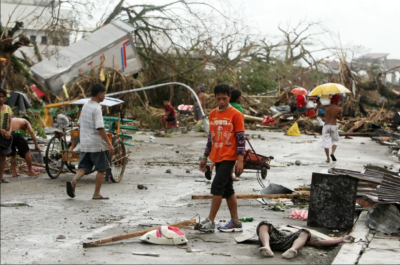Thoughts, Prayers, and Typhoons: Catholicism in the Midst of a Disaster
“To God Be the Glory.” It says at the end credits of a Filipino telenovela playing on tv at a family friend’s living room. Growing up as a Filipino-Canadian, who was used to more “secular” Canadian media content, I have always thought this was such a bizarre statement to have at the end of a T.V. show. You would never see a statement like this at the end of a Degrassi episode. Catholicism and the Philippines go together like pansít and lumpia – one cannot exist without the other.
From a restrictive lens, this relationship can be interpreted merely as a product of colonialism. However, without overlooking the prevalent colonial influence on this matter, we can also attempt to approach it from a different angle. For instance, looking at it from a migration studies perspective, religion and shared faith can be incredibly beneficial for newcomers who do not have family and friends in their new home country. Religion is so ingrained in Filipino culture that it is not uncommon for new immigrants to seek out a Catholic church community as soon as they arrive in Canada. Organized religion such as Catholicism can help create a solid support system for new and established immigrants, while also keeping them spiritually and emotionally close with family back home, especially during times of strife and hardship.
In November 2013, Filipino-Canadians, among others, were awoken with terrible news that the Philippines was hit by one of the most powerful tropical cyclones ever recorded. Typhoon Haiyan killed over 6,000 people (plus over 1,700 people missing) and costed approximately $2.98 billion (USD) worth of damages. This catastrophic event made waves internationally, affecting not only residents of the Philippines, but their loved ones living abroad.

While remittances are not a foreign concept within the context of Filipino migration, this disaster weighed heavily on Filipinos living and working in Canada. Personally, I can remember all the fundraisers within the Filipino and Asian community in Winnipeg. However, as I was looking back on archived news articles regarding the typhoon, I could not help but notice how these articles were framed. I was particularly drawn to some articles from The Filipino Journal (based in Winnipeg, Manitoba) that centred the Catholic church and their contributions to the typhoon disaster relief.
This had me thinking deeply about the seemingly perpetual relationship between colonial religious beliefs and the colonized. According to the Philippine Statistics Authority census of 2020, Roman Catholics account for 78.8% of the Filipino population. The Philippines has been free of Spanish rule since 1898, yet Catholicism still remains the most prominent religion in the country. So do I dare assume that there is a correlation between the Philippines’ long history with natural disasters and the prominence of organized religion in the country?
Disasters not only destroy buildings and living spaces, and inflict physical injuries, they also carve a substantial amount of emotional and mental trauma on survivors. In a developing country like the Philippines, it is presumable that people with lower socioeconomic status tend to suffer more during disasters. Catastrophic events provoke intense feelings of anxiety and distress, especially for lower-class folks who struggle financially. Religion, or turning to God during these times, offer a sense of security, safety, hope, or even explanation (ie. “This is part of God’s greater plan”) in times of strife.
Prior to diving into these relationships through extensive research, the connection between Catholicism, colonialism, and disasters in the Philippines left a bad taste in my mouth. However, after taking a step-back and checking my positionality as a privileged Filipina woman in North American academia, I realized that these discourses are more complex than they appear, in times of distress. Colonialism has a large part to play in the continued dominance of Catholicism in the Philippines, however, we also need to consider other factors such as, but not limited to, the frequency of disasters in the country, and the socioeconomic status of folks who are most vulnerable during these events.
– Denie Espina